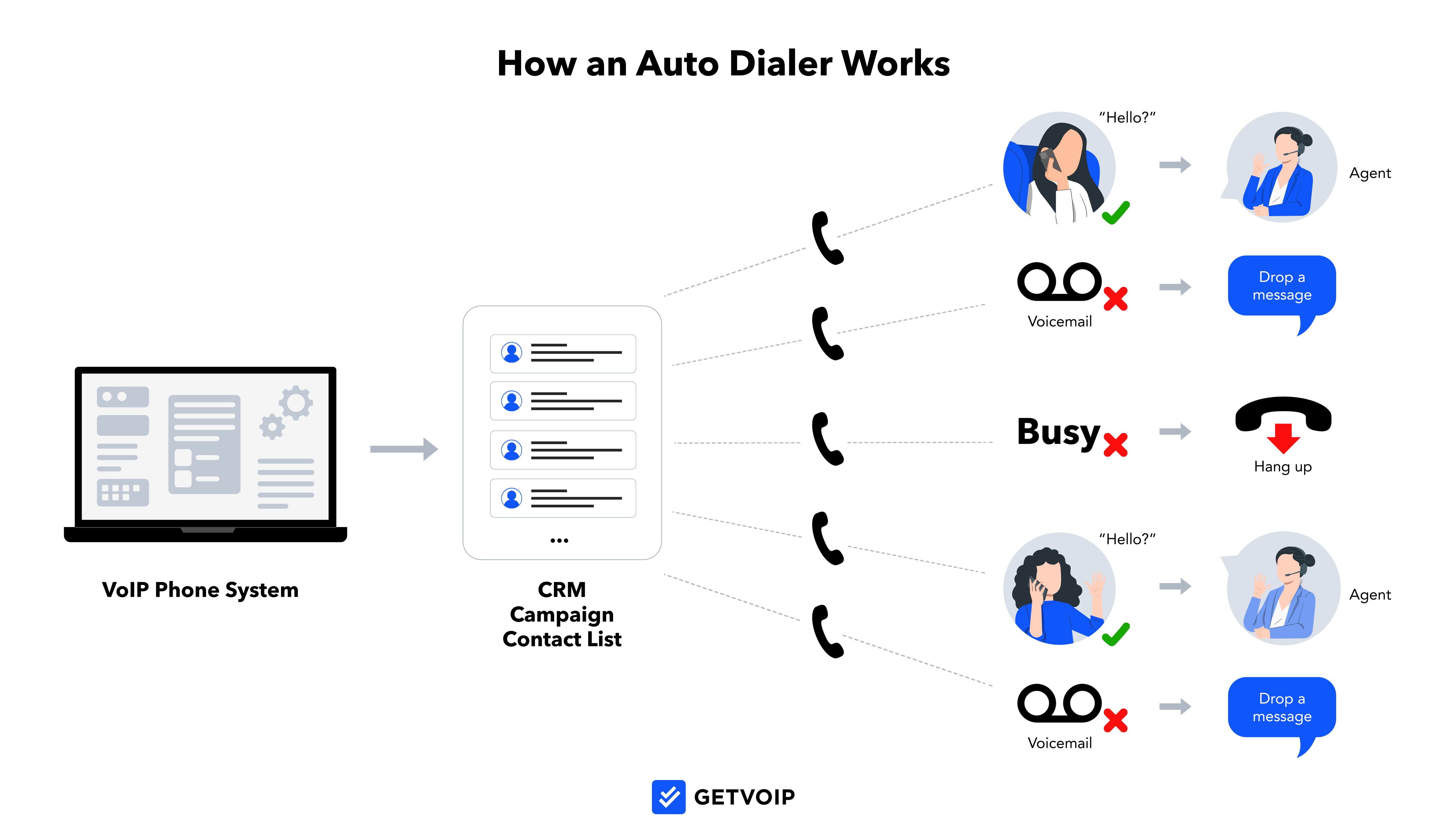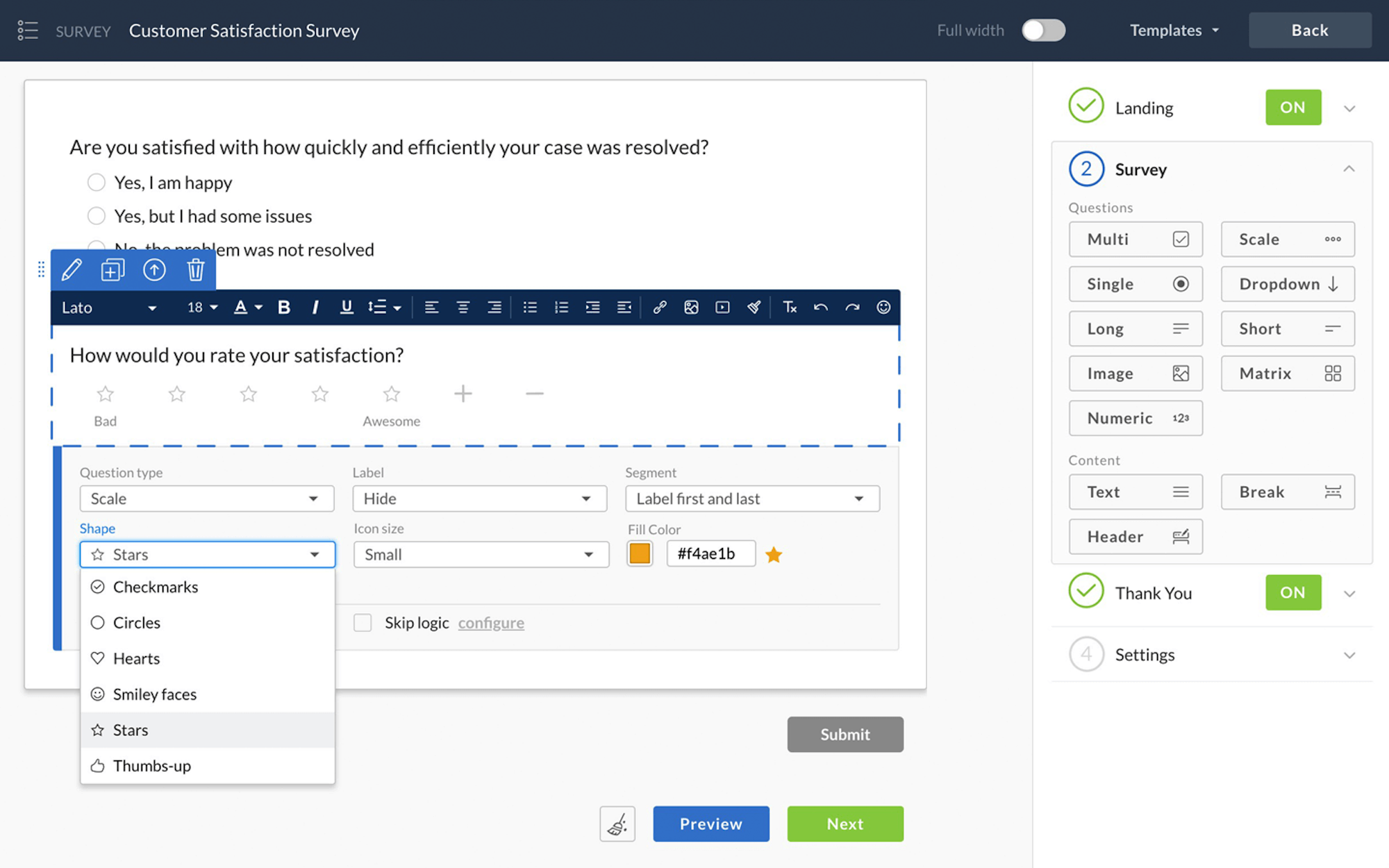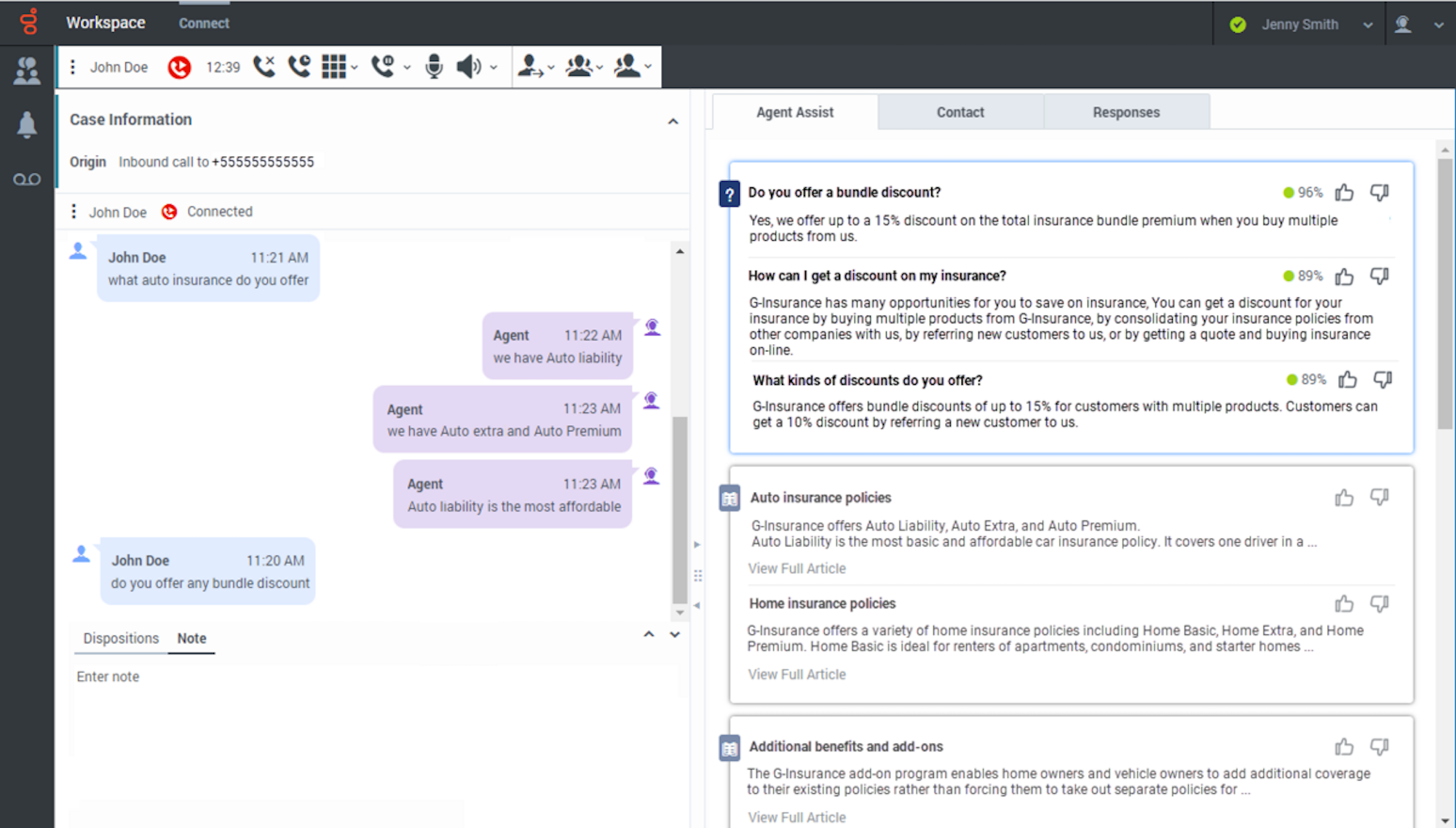Outbound call centers are an essential part of your business communications strategy, facilitating sales calls, customer relationship management, and a better understanding of your target market.
Today’s outbound call centers are about far more than just cold calling: they help agents provide the kind of proactive service and support that can increase revenue by up to 30%--while simultaneously boosting customer retention and satisfaction rates.[*]
This post highlights key outbound call center software features, top use cases, essential KPIs, and best practices to optimize outbound call center performance.
What Is An Outbound Call Center?
An outbound call center is a business that makes outgoing sales or support calls to existing customers, new leads, and other prospects. Outbound call centers can be in-house operations, fully remote, or employ hybrid agents.
Outbound call center agents:
- Cold call lead lists to qualify leads, collect lead contact information, and sell products/services to new customers
- Cross-sell/up-sell to existing customers, renew existing customer subscriptions
- Provide proactive customer support or make follow-up calls responding to customer service and support requests
- Make outbound calls to manage client relationships and increase customer retention, collect customer feedback, and conduct market research
- Use automated voicemail drops to leave messages marketing products and services, soliciting donations, or attempting to collect payments/debts from existing customers
- Make or confirm appointments, collect and update essential customer contact and account information
Popular Outbound Call Center Use Cases
The most popular use cases for outbound call centers are:
- Telemarketing: Cold calling lead lists, following up with prospective customers/existing leads, collecting important lead data like phone numbers, email addresses, etc.
- Sales Calls: Calling existing customers and top-tier leads with specific offers for products and services tailored to their interests, cross-selling and upselling
- Support Calls: Providing technical support to existing customers for products/services, returning customer service requests received on multiple communication channels, or offering proactive customer support via product inquiries
- Customer Relationship Management: Courtesy calls that aren’t trying to sell customers anything, but instead focus on customer retention, relationship-building, and ensuring customers feel valued. Agents can thank happy customers who recently made a purchase or left a positive review, and check in with unhappy customers to resolve their issues and empathize with them
- Customer Surveys: Automated or agent-led post-call surveys that collect customer input, identify common customer pain points, and evaluate customer satisfaction levels. Depending on the complexity of the survey, customers can respond via the dial pad touch tone or speak their responses into the phone
- Reminders and Confirmations: Calling customers with appointment reminders/confirmations, bill payment or collections reminders/confirmations, shipping and order tracking updates, collecting essential customer data and pre-filling forms before upcoming appointments, etc.
- Fundraising and Campaigning: Pre-recorded or live calls soliciting donations for non-profits or political campaigns, raising awareness for social causes or upcoming elections, campaigning for specific political candidates, etc.
- Target Market Research: Calling leads, existing customers, other businesses, and other members of your target demographic with polls and questionnaires that help your marketing team learn more about your customer base, their needs and expectations, the kinds of products/services they’re interested in, etc.
Benefits of Outbound Call Center Software
The top benefits of outbound call center software are:
- Increased Revenue: Outbound call center software revolutionizes telemarketing and telesales processes by filtering out non-working numbers, connecting agents to live leads only, and giving agents instant access to essential customer data. Most importantly, outbound call centers enable proactive customer engagement–which can increase revenue by at least 30%.[*]
- Lower Operating Costs: AI-powered call center agent scheduling and forecasting tools optimize available agents, eliminating the need to hire additional reps to meet high call volumes. CRM screen pops and AI-powered next-best-action suggestions increase FCR and shorten call times, lowering the average cost per call.
- Increased Productivity: Automated lead list management and after-call work, eliminates manual dialing, and gives managers access to in-call agent coaching to increase FCR. More advanced tools, like AI Agent Assist, can increase agent productivity levels by up to 14%.[*]
- More Efficient Business Processes: Real-time and historical KPIs like average handle time (AHT), first call resolution rate (FCR), and average call hold times help call center managers identify call volume trends, improve IVR self-service menus, and optimize agent schedules. More detailed customer survey feedback reveals trends in customer sentiment, satisfaction, and overall experience. Together, these findings can be used to optimize and automate time-consuming business processes, address top customer concerns, and improve the support experience.
- Personalized Customer Service: In-call CRM CTI screen pops and helpdesk integrations give agents in-call access to essential customer data, omnichannel conversation histories, and notes from other agents–enabling highly personalized yet efficient customer service. Providing a personalized CX can increase marketing ROI by up to 30%, boost revenue by up to 15%, and cut customer acquisition costs in half.[*]
- Higher Customer Retention Rates: Follow-up calls, appointment reminders, sales calls, and customer phone support all make customers feel prioritized and valued–and ensure customers don’t forget about your company. Given that increasing customer retention rates by just 5% can increase profits by up to 25%, there’s real value in consistently checking in on existing customers.[*]
- Decreased Inbound Call Volume: Proactively calling and following up with existing or potential customers dramatically decreases daily inbound call volumes, keeping call queues short and live agents free to assist more customers. Leveraging insights from customer interaction analytics and other call center KPIs decreases call volumes by reducing call times by 82 seconds and lowering repeat calls by 5%.
Differences Between Inbound vs Outbound Call Centers
The main difference between inbound and outbound call centers is the call direction: while outbound call centers make outgoing calls, inbound call centers receive inbound calls. The secondary difference is that inbound call centers usually manage customer service and support requests, while outbound call centers focus on lead generation, prospecting and sales, and follow-up calls. Blended call centers manage both inbound and outbound calls.
Additional differences between inbound call centers and outbound call centers are shown in the table below:
| Outbound Call Center | Inbound Call Center | |
| Call Direction | Makes outgoing calls to customers/leads | Receives incoming calls from customers |
| Use Cases |
|
|
| Key Features |
|
|
| Essential KPIs |
|
|
Key Outbound Call Center Features
Below, we’ve outlined the most important outbound call center software features to look for, including auto dialers, customer surveys, call monitoring, and lead list management tools.
Outbound Auto Dialers
Outbound automated dialers with multiple dialing modes are easily the most important outbound call center software functionality. These dialers eliminate manual dialing by automatically dialing lead list telephone numbers and only connecting agents to live prospects who are ready to talk.

There are three main auto dialing modes:
- Power dialer: Automatically places the next outbound call immediately after the current call has ended
- Predictive dialer: Uses a call pacing algorithm to automatically place the next outbound call while the agent is wrapping up their current call, eliminating idle time between calls. Predictive dialers can place multiple outbound calls simultaneously and automatically adjust the outbound call pace
- Preview dialer: Once the current call has ended, agents can indicate when they’re ready for the dialer to place the next outbound call or skip the next number on the lead list. When integrated with CRM systems, agents can also review customer/lead data and call notes before dialing the next number, giving them time to fully prepare for the call
Additional auto dialer capabilities include:
- Call pacing ratio/algorithm: Agents or admins can adjust the outbound dialing speed according to the current call center/agent activity
- DNC compliance: Automatically filters out phone numbers on the Do-Not-Call list, updates customer DNC list preferences
- Lead list scrubbing: Also called unproductive number detection, lead list scrubbing automatically filters out disconnected or busy numbers (admins can also opt to filter out voicemail boxes)
- Lead list generation: Automatically generates lead lists from publicly available customer/prospect data, including data pulled from social media and other websites
- Predictive lead scoring: Predictive lead scoring uses AI and machine learning to analyze behavioral data, firmographics, and negative data to automatically quality leads and determine the likelihood that a lead will make a purchase
- Voicemail drop: Automatically leaves a pre-recorded voicemail message in a prospect’s voicemail box without ringing the lead’s phone (instead, the prospect receives a new voicemail message notification)
- Answering Machine Detection (AMD): Automatically determines if an outbound call has connected to a voicemail box instead of a human, then initiates a voicemail drop or skips the number according to preset rules
- Automated post-call work: Automatically logs call notes and customer data (included across integrated third-party platforms), scores leads, schedules/assigns follow-up calls, and scores customer sentiment and agent performance. AI-powered after-call work tools may also generate automatic call summaries, identify key moments, create tasks related to call outcomes, and transcribe calls in real time
- Automated callbacks: If the customer is interested but currently unavailable, they can request a specific time/date to receive a callback/follow-up from a sales rep
- Outbound IVR: Connects call recipients to a pre-recorded automated call menu instead of a live agent (ideal for agentless lead qualification, fundraising, bill collection, etc.)
Customer Surveys
Customer feedback tools let admins create fully customized or template-based customer surveys. These surveys come in a variety of formats, including open-ended questions, multiple choice, star or number rankings, etc.

Surveys can be sent out to customers automatically post-call, shared via email, embedded on the company website, or be the subject of a separate follow-up call. Survey design tools let admins add and edit questions, select specific KPIs, set survey stop dates, and allow customers to choose multiple responses. For security, admins can add CAPTCHAs, limit the number of survey responses per customer, and block specific IP addresses.
Some providers display real-time customer survey results, while others offer detailed speech/text analytics that include trending topics, word clouds, and customer sentiment/intent monitoring.
Surveys are especially valuable for determining current outbound call center CSAT and NPS scores.
Call Monitoring
Call center managers can listen in on real-time calls via call monitoring or review call recordings and transcripts at a later date. Call whisper lets managers provide live in-call agent coaching without the customer hearing them. Call barge lets managers take over calls requiring immediate escalation.

Some call center solutions include advanced in-call coaching tools like:
- In-call AI Agent Assist with knowledge base integration and next-best-action suggestions
- Customizable agent scorecards
- Live, one-on-one in-call coaching from a manager via chat messaging
- Post-call training module assignment and automated QA
Call Scripting
Call center managers use the call script feature to build, edit, and share pre-written sales and support scripts with agents. Call scripts can be customized with if-then logic and objection handling. They can also integrate with CRM tools for automatic script personalization. Admins can assign specific scripts to lead lists or marketing campaigns, run A/B testing on sales pitch scripts, and create a searchable call script database for agents.
In addition to basic call scripts, some outbound call centers may include canned responses. Canned responses are shorter, pre-written answers to the most common customer queries that agents can read out loud during voice calls. Admins can create and edit searchable canned response libraries. AI-powered call centers use machine learning and Natural Language Understanding to automatically display relevant canned responses on agent screens during live customer conversations.
Third-Party Integrations
Outbound call center software offers extensive third-party integrations with helpdesk, CRM, marketing, sales, and team collaboration applications. These integrations give agents in-call access to essential customer data, lead list updates, call scripts, and even workforce management tools.
Popular business communication tools your outbound call center should integrate with include Salesforce, ServiceNow, ZohoCRM, Gong, Marketo, HubSpot, Pipedrive, and ActiveCampaign.
Top Outbound Call Center KPIs
Below, we’ve outlined the most important outbound call center KPIs, how to calculate them, and the industry standard for call centers. Most call centers include both real-time and historical analytics, custom reporting, and advanced AI-powered speech and text analytics to highlight customer experience trends.
Conversion Rate
- Definition: The percentage of total outbound calls that result in a sale
- Industry Standard: 2-3% for cold calls, higher for existing customers
- Formula: CVR=(Total number of conversions➗total number of outbound calls) x 100
Speed to Lead Time
- Definition: How long it takes agents to contact leads, starting from the moment prospects opt-in or show an interest in your product/services
- Industry standard: Varies dramatically by industry and business size, general average of 47 hours
- Formula: LRT=Time and date when new lead was received–time and date when lead was contacted
Call Answer Rate
- Definition: The percentage of outbound calls that customers/leads answer
- Industry standard: 25-35%
- Formula: CAR=(Total outbound calls answered➗total number of outbound calls) x 100
Cost per Call
- Definition: The average total cost of each outbound call (cost per acquisition measures the total cost of each conversion or the total cost of each new customer)
- Industry standard: $2.70-$5.60 per call
- Formula: CPC=Total call center operating costs➗total outbound call volume
Average Outbound Call Volume
- Definition: The number of outbound calls made over a specific period of time, by an individual agent, by a specific department, etc.)
- Industry standard: 60 daily outbound calls per agent
- Formula: Average weekly call volume=number of daily outbound calls made x 7
Average Talk Time
- Definition: The average amount of time an agent spends talking to a customer per outbound call (not including pre/post-call work, call hold time, or call queue time)
- Industry standard: About 6 minutes per call
- Formula: ATT=(Average handle time–hold time–After-call work time)➗total number of outbound calls
After-Call Work Time (ACW)
- Definition: The amount of time it takes agents to complete all call-related tasks once the active call with the customer has ended (CRM data entry, order placement, call notes, etc.)
- Industry standard: 45 seconds per call
- Formula: ACW=Total amount of time spent on post-call tasks➗total number of outbound calls made
Agent Occupancy Rate
- Definition: The percentage of time agents spend actively speaking to leads and managing other call-related tasks (the remaining time is known as “idle time”)
- Industry standard: 80-83%
- Formula: Occupancy rate=[Total call handling time➗(total call handling time+total agent available time)] x 100
Customer Retention Rate
- Definition: The percentage of existing customers that remain active customers at the end of a specific time period (month, quarter, year, etc.)
- Industry Standard: Varies by industry, the telecommunications industry has an average customer retention rate of 78%
- Formula: CCR=[(Final number of customers– number of new customers)➗initial number of customers] x 100
Dos and Don'ts for Your Outbound Call Center
Once you’ve found the right outbound call center software, follow the below best practices–and know what to avoid–to optimize your outbound calling strategy while providing a superior customer experience.
Do:
- Prepare for the call: When following up with existing customers or high-quality leads, agents should review existing CRM data and agent notes before speaking to the prospect.[ CTI screen pops and preview dialing modes enable in-call access to essential customer data
- Segment your market: Market segmentation is the process of creating groups of buyers with similar customer personas, demographics, and shopping habits. Effective market segmentation increases consumer spending, creates loyal customers, and ensures agents don’t waste time pitching leads products or services they have no interest in.
- Regularly review analytics: Review live and historical call center metrics at regular intervals to find trends in consumer buying patterns, agent activity, and call volumes. Insights from analytics highlight best-selling products/services, top-performing agents, effective call scripts, and even roadblocks in the customer buying journey
Don't:
- Neglect DNC list compliance: Especially if you’re using auto dialers, ensure you are compliant with Do Not Call List regulations and always avoid callers DNC-registered numbers. DNC violations can easily carry up to $25,000 in fines–per call.
- Use aggressive marketing tactics: Avoid calling the same phone numbers over and over, do not call customers outside of normal business hours, and instruct agents to end calls when a customer becomes abusive. Instead, focus on developing call center agent soft skills like empathy, active listening, and verbal communication.
- Over-Automate: Call center software includes advanced automation capabilities that streamline business processes and increase productivity–but there is such a thing as overly automated communication. Customers want to talk to a real person–and received personalized sales pitches about products they’re genuinely interested in.
FAQs
Below, we answer some of the top outbound call center FAQs.



